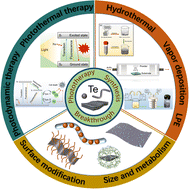Advances of bioactive tellurium nanomaterials in anti-cancer phototherapy
Abstract
Tellurium nanomaterials show unique advantages, including high carrier mobility, excellent optical properties, and high specific surface areas. Although previous studies have confirmed the application of tellurium nanomaterials in the biological field, their biocompatibility, metabolism, and potential toxicity in organisms demand further exploration. This review systematically summarizes the application of tellurium nanomaterials in the field of tumor phototherapy. Firstly, the common synthesis methods of tellurium nanomaterials are elaborated, mainly including solid-phase deposition, liquid-phase exfoliation, the solution synthesis method, and molecular beam epitaxy. Secondly, the review summarizes the research progress of tellurium nanomaterials in tumor photothermal therapy, photodynamic therapy, photo-triggered molecule delivery, and synergetic therapy. Moreover, we emphasize some breakthroughs in these fields, such as surface-modification and size-control strategies of tellurium nanomaterials. Finally, future prospects are also discussed. The excellent characteristics of tellurium nanomaterials and their relative lack of exploration also suggest that they may have more application opportunities in the near future. This review aims to demonstrate the significance of tellurium nanomaterials in biomedicine and to provide strategies to expand their application in phototherapy.

- This article is part of the themed collection: Recent Review Articles


 Please wait while we load your content...
Please wait while we load your content...